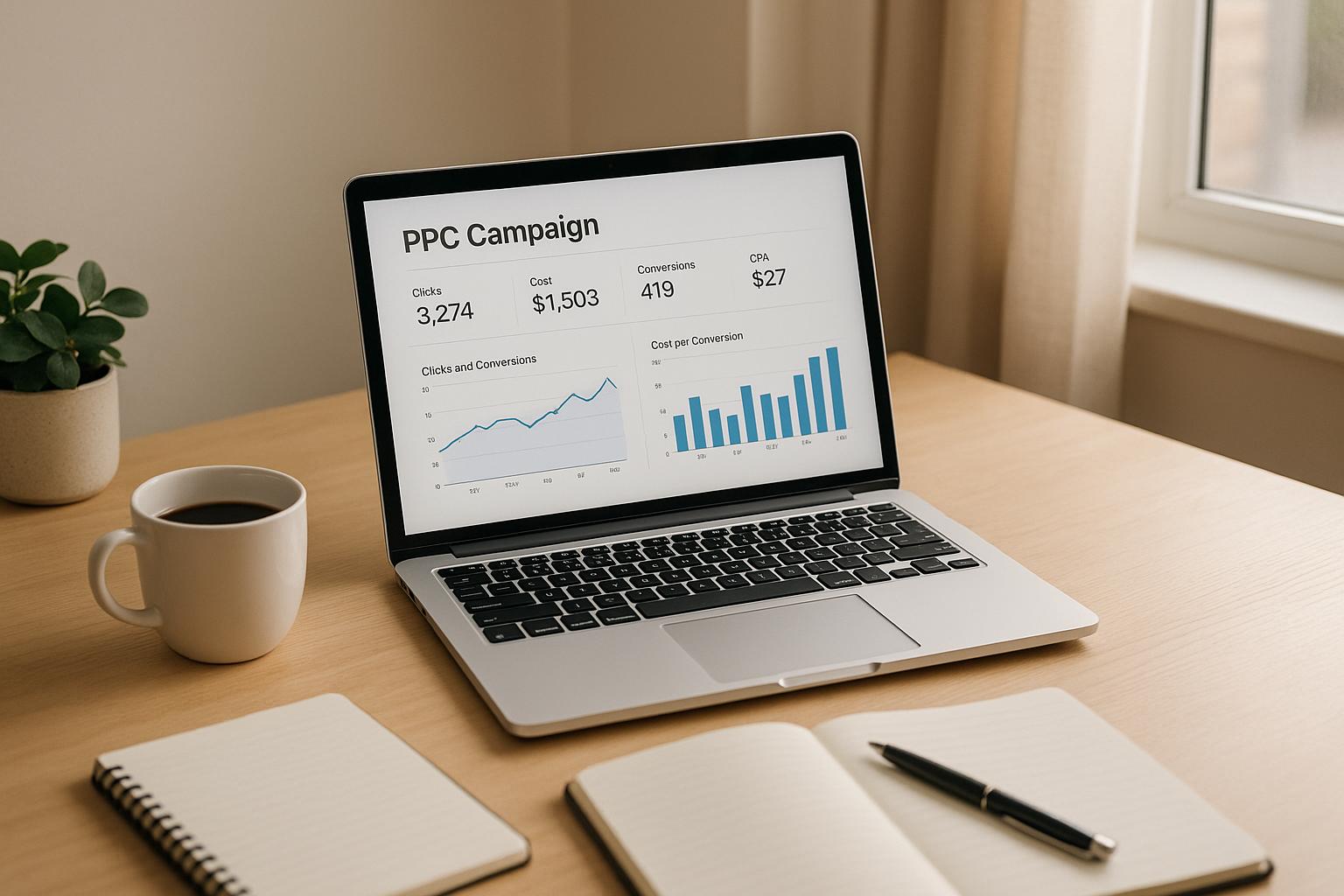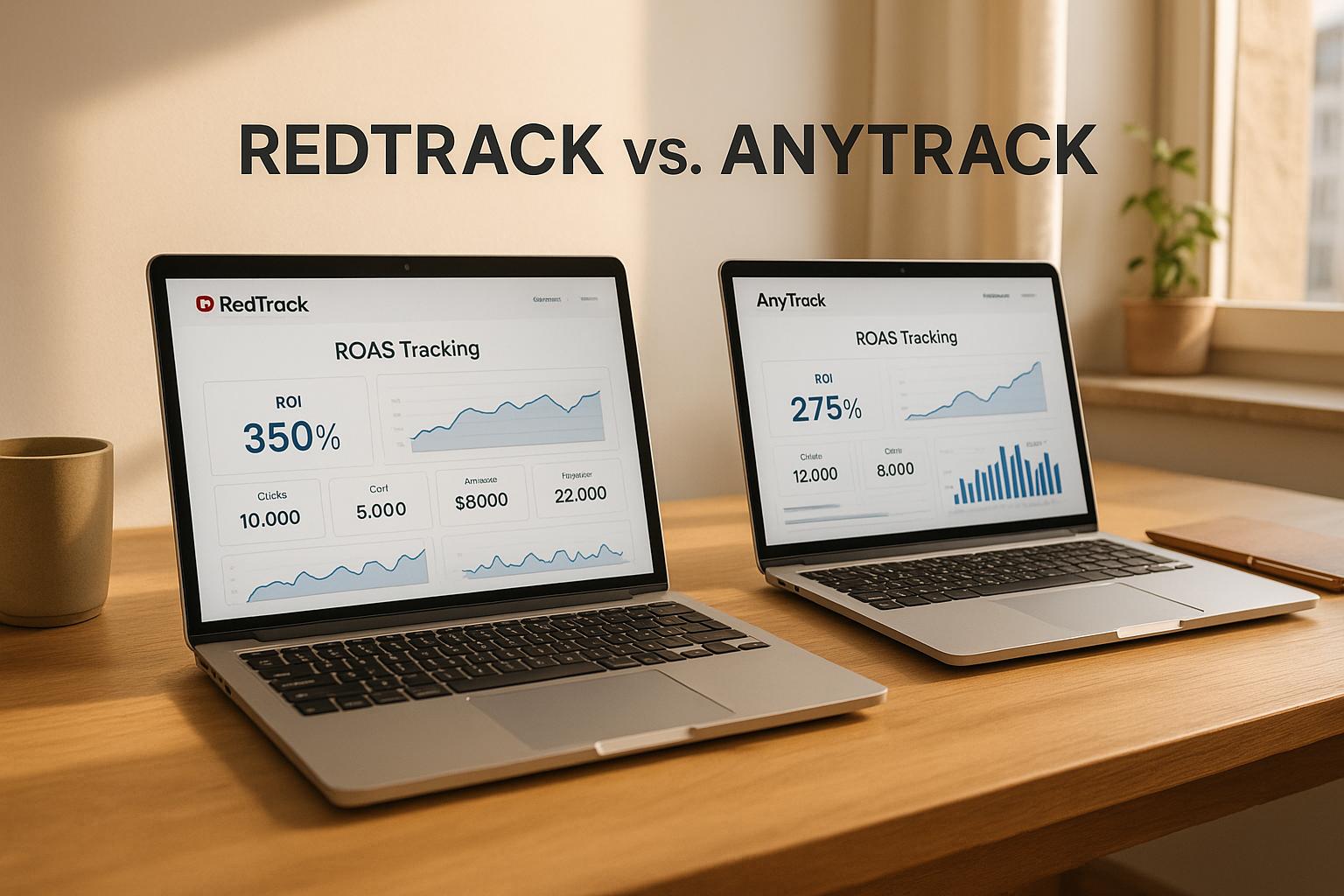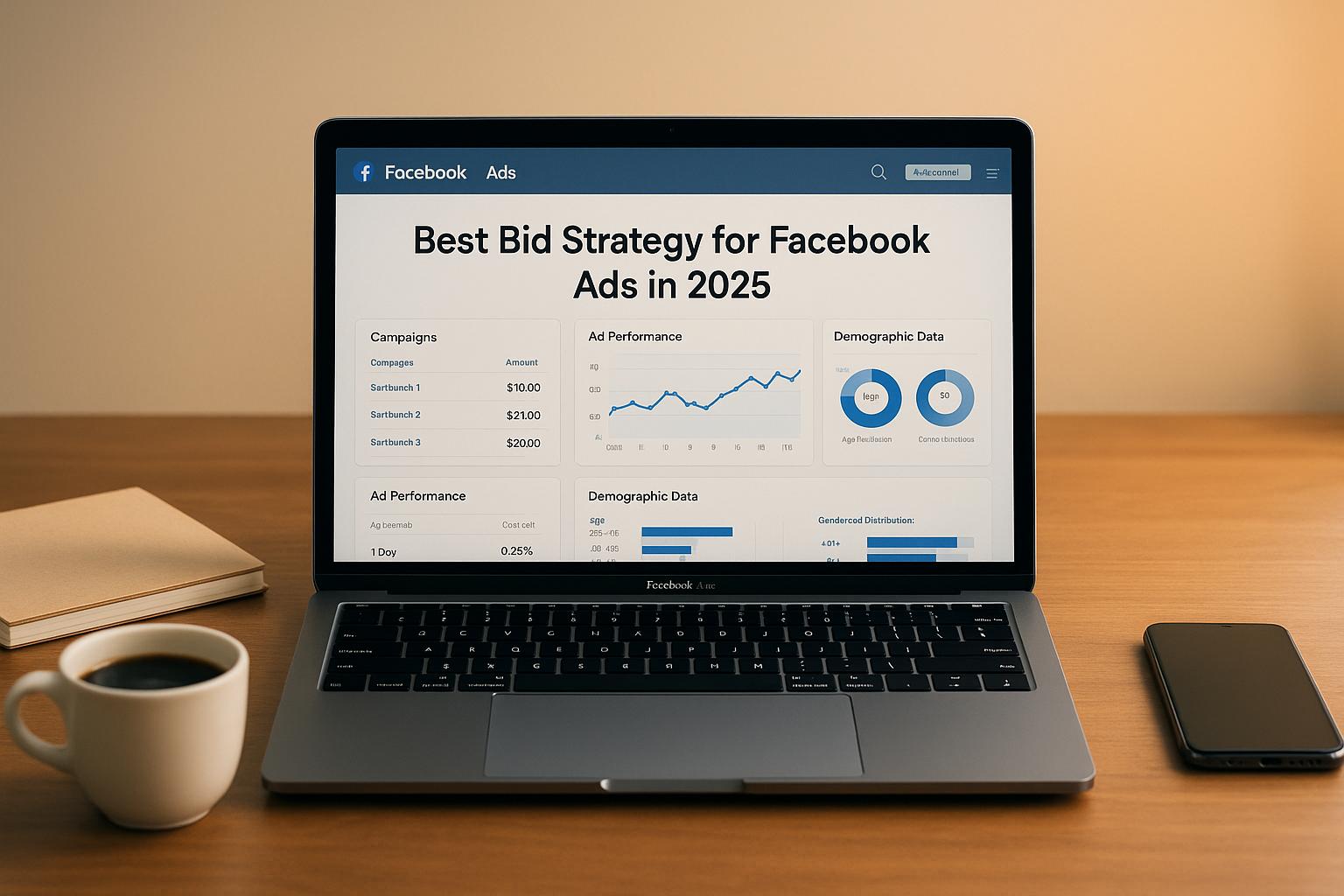Cross-platform keyword tools simplify managing PPC campaigns across platforms like Google Ads and Microsoft Advertising. They save time, improve performance, and ensure consistency. Here's what they offer:
- Platform Synchronization: Sync keywords, bids, and settings across platforms in real-time.
- Combined Reporting: Unified dashboards for metrics like CTR, CPC, ROAS, and more.
- Keyword Research: AI-powered suggestions and competitor analysis for better targeting.
- Bid Management: Adjust bids for all platforms from a single interface.
- Performance Alerts: Real-time notifications for budget issues, performance drops, and more.
- Large Campaign Management: Bulk editing, automated rules, and organized structures for handling complex campaigns.
- Platform Connections: Integrations with Google Ads, Microsoft Advertising, Meta Ads, and others.
Keyword Rules Automation for Cross-Platform PPC Management
Why Use Cross-Platform Keyword Tools
Cross-platform keyword tools simplify campaign management and improve overall performance, making them a valuable asset for PPC marketers.
Save Time and Resources
Managing separate campaigns often means juggling multiple interfaces and manually coordinating efforts. Cross-platform tools bring everything into one place, allowing marketers to work more efficiently.
Better Data Analysis
These tools combine performance data from different platforms into a single, easy-to-read report. With real-time metrics and a clear view of channel trends, marketers can make smarter, data-driven decisions. This unified data approach also helps optimize spending.
Smarter Budget Allocation
Seeing performance across all platforms in one place makes it easier to allocate budgets effectively. Marketers can:
- Shift funds to platforms delivering better results
- Spot underperforming keywords
- Adjust bids based on comprehensive data
- Ensure balanced spending across all campaigns
Keep Campaigns Aligned
Consistency is key to maintaining a strong brand presence across platforms. Cross-platform tools help ensure:
- Keywords remain aligned across channels
- Bid strategies match broader campaign objectives
- Ad copy stays uniform across networks
- Campaign settings are applied consistently where needed
These tools have grown into essential resources for PPC marketers, offering the tools needed to streamline workflows and maximize campaign results.
1. Platform Synchronization
Platform synchronization ensures that data flows smoothly between different advertising platforms, keeping keyword information, campaign settings, and performance metrics aligned. This integration is key to managing campaigns across multiple platforms efficiently.
Real-Time Data Exchange
Cross-platform keyword tools maintain active connections with major platforms. Any changes you make in the tool - like adjusting keyword bids, updating budgets, tweaking targeting, or modifying schedules - are automatically applied across all linked platforms. Similarly, updates made directly on the platforms are instantly reflected in the tool, keeping everything in sync.
Performance Impact
By automating updates and reducing manual input, synchronization minimizes errors and ensures campaigns stay consistent. This allows for quicker adjustments to market changes, providing teams and agencies managing multiple accounts with the data they need to make informed decisions and improve campaign outcomes.
2. Combined Performance Reports
Combined performance reports bring all your PPC metrics into one place, making it easier to analyze campaigns across multiple platforms. By using a single dashboard, you avoid jumping between interfaces, saving time and gaining clearer insights.
Unified Metrics Dashboard
The best tools for cross-platform keyword tracking pull together key metrics such as:
- Click-Through Rate (CTR) from all platforms
- Cost Per Click (CPC) comparisons
- Conversion rates and total conversions
- Return on Ad Spend (ROAS)
- Quality Score details
- Impression share figures
Advanced Data Visualization
Interactive charts transform raw data into actionable insights, letting you compare performance side by side across platforms.
Custom Report Generation
With custom reporting, you can:
- Build dashboards tailored to specific KPIs
- Schedule automated reports for regular updates
- Perform cross-platform trend analysis
- Export data in formats suited for deeper dives
These reports make it easier to compare and improve performance across platforms.
Performance Benchmarking
One major benefit of combined reports is the ability to benchmark results across platforms. This helps you spot areas where strategies from one platform could be applied to another, boosting overall campaign results.
| Metric Type | Reporting Capability | Business Impact |
|---|---|---|
| Real-time Metrics | Immediate updates across all platforms | Quicker reactions to market shifts |
| Historical Data | Insights into long-term trends and seasonality | Smarter strategic planning |
| Competition Analysis | Competitive insights across platforms | Better-informed bidding strategies |
3. Keyword Research Tools
Keyword research tools help identify and analyze terms that can drive better results across multiple platforms, making it easier to make informed decisions.
AI-Powered Keyword Suggestions
Many tools now use AI to identify promising keywords. By studying search trends and user behavior, these tools recommend keywords that could perform well. They also assist in analyzing competitors' strategies, giving you an edge in targeting the right terms.
Competitor Analysis
These tools also keep track of the keywords your competitors are using, offering insights into their strategies and helping you refine your own approach.
sbb-itb-89b8f36
4. Multi-Platform Bid Control
Managing bids across multiple platforms can be tricky. Cross-platform tools simplify this by giving you a single dashboard to adjust bids. This streamlined method ensures your bidding strategy stays aligned across all channels.
Unified Bid Adjustments
Rather than juggling multiple platforms, you can update bids for all channels at once. This not only saves time but also helps maintain a consistent approach to your bidding strategy.
5. Platform Connections
Cross-platform keyword tools work best when they integrate easily with major advertising platforms and important marketing tools. For PPC campaigns, connecting across multiple channels ensures smooth operations and maximizes ROI.
Core Platform Integration
The most important advertising platforms to connect with include:
- Google Ads: Supports search, display, and shopping campaigns
- Microsoft Advertising: Includes Bing and Yahoo networks
- Meta Ads: Covers Facebook and Instagram advertising
- Amazon Advertising: Focused on e-commerce and marketplace campaigns
These direct integrations allow for smooth data flow and make campaign management more efficient.
Third-Party Tool Compatibility
In addition to primary platforms, third-party tools play a big role in tracking and improving campaign performance.
| Tool Category | Purpose | Benefits |
|---|---|---|
| Analytics Platforms | Track performance | Centralized data analysis across channels |
| CRM Systems | Manage customer data | Better audience targeting and segmentation |
| Conversion Tracking | Attribute revenue | Accurate ROI measurement across platforms |
These tools make it easier to monitor results and fine-tune campaigns.
API Reliability
Strong platform connections rely on stable APIs. Here's why they matter:
- Real-time updates: Ensure changes are reflected across platforms instantly
- Automated error handling: Fix connection issues without needing manual intervention
Reliable APIs bring together data from platforms and tools, creating a connected and efficient system.
Data Security Standards
Security is just as important as functionality. Essential measures include:
- Data encryption: Keeps information safe during transfers
- Authentication protocols: Prevents unauthorized access
- Compliance certifications: Ensures adherence to industry data protection standards
These measures not only protect your data but also support smooth and secure campaign management.
6. Performance Alerts
Performance alerts act as your digital lookout, keeping you informed about real-time shifts in keyword performance across various ad platforms. They work hand-in-hand with the synchronized data and combined reporting tools mentioned earlier.
What Do They Monitor?
These tools keep an eye on critical metrics, including:
| Alert Type | Metrics Tracked |
|---|---|
| Budget Alerts | Daily spend, budget pacing |
| Performance Drops | Click-through rate (CTR), conversion rate |
| Competitive Shifts | Average position, cost-per-click (CPC) |
| Quality Issues | Quality score, ad relevance |
How to Set Up Smart Alerts
You can tailor alerts to your needs by:
- Setting thresholds for specific campaigns or platforms
- Assigning priority levels (e.g., critical, warning, informational)
- Creating automated rules to trigger actions instantly
How Alerts Reach You
Get updates through your preferred channels, such as:
- Real-time dashboard notifications
- Email summaries
- Mobile push notifications
- SMS for urgent updates
Connecting the Dots Across Platforms
One standout feature of these alerts is their ability to identify trends across multiple ad networks. For instance, if a keyword starts underperforming on one platform, the system can analyze whether the same issue is cropping up on other networks.
Building a Response Plan
To handle alerts effectively, follow these steps:
- Define baseline metrics to understand what "normal" looks like.
- Create action plans for each type of alert.
- Track recurring patterns to fine-tune your strategies.
This structured approach ensures you're ready to act when performance shifts occur.
7. Large Campaign Management
Handling large-scale keyword campaigns across multiple platforms requires the right tools to keep things running smoothly. Advanced tools not only synchronize platforms and combine reporting but also make managing massive campaigns far more efficient.
Bulk Management Features
Managing multiple campaigns becomes easier with features designed for large-scale updates. Here's a quick look:
| Feature | What It Does | Why It Matters |
|---|---|---|
| Mass Editing | Update all platforms at once | Cuts down on manual effort |
| Template Systems | Standardize campaign setups | Keeps things consistent |
| Automated Rules | Adjust settings automatically | Helps maintain performance |
| Duplicate Detection | Identify overlapping keywords | Avoids conflicts and waste |
Resource Optimization
When you're dealing with large campaigns, efficient resource use is key. Tools that optimize resources include:
- Smart Chunking: Break large datasets into manageable pieces for easier synchronization.
- Parallel Processing: Update multiple platforms at the same time to save time.
- API Rate Management: Ensure platform request limits are respected to avoid downtime.
- Memory Optimization: Process data effectively without overwhelming systems.
Organizational Structure
A well-organized campaign structure makes large campaigns easier to manage. Here’s how modern tools help:
- Hierarchical Management: Group campaigns by business unit, region, or product for better organization.
- Label Systems: Use custom tags and automated classification to simplify keyword management.
- Version Control: Track changes, roll back if needed, and compare performance over time.
These features ensure campaigns remain organized and consistent, no matter how complex they get.
Performance Scaling
Scaling campaigns requires tools that can handle large keyword sets without slowing down. Key features include:
- Progressive Loading: Manage huge keyword lists without crashing systems.
- Smart Filters: Quickly find specific keywords when needed.
- Batch Processing: Schedule updates to avoid platform overload.
- Performance Forecasting: Preview how changes might impact results before rolling them out.
Data Management
Data is the backbone of any campaign. Effective data management tools offer:
| Aspect | What It Does | Why It Helps |
|---|---|---|
| Storage | Cloud-based architecture | Handles massive data volumes |
| Processing | Distributed computing | Enables real-time analysis |
| Backup | Automatic redundancy | Keeps data safe and secure |
| Recovery | Point-in-time restore | Minimizes risks and downtime |
With these features, managing large campaigns becomes more streamlined, ensuring data-driven decisions and smooth execution at any scale.
Selecting Your Keyword Tool
Now that we've covered key features, let's dive into how to pick the right tool for your PPC strategy.
Key Factors to Consider
When evaluating tools, compare your needs against these factors:
| Factor | What to Look For | Why It Matters |
|---|---|---|
| Campaign Scale | Keywords and accounts | Determines processing capacity |
| Platform Mix | Advertising networks | Ensures proper integration |
| Budget Range | Monthly tool costs | Affects access to features |
| Team Size | Number of users needed | Impacts licensing requirements |
| Technical Needs | API and automation | Aligns with your tech setup |
Budget and Features
Balance your tool choice with your PPC budget and campaign size. Compare pricing tiers to ensure you're getting features that match your needs without overspending.
Technical Capabilities
Make sure the tool supports your technical requirements, such as API integrations, data processing power, user access levels, and update frequency.
Steps to Evaluate Tools
- Do Your Homework Start by visiting resources like the Top PPC Marketing Directory (ppcmarketinghub.com) to narrow down options based on your requirements.
-
Match Features with Needs
Identify the capabilities you can’t compromise on. For example:
Priority Category Examples Critical Core Functions Sync, reporting Important Advanced Automation, alerts Optional Extras Custom views -
Try Before You Commit
Use trial periods to test tools for:
- Data accuracy
- Speed and responsiveness
- User-friendly interfaces
- Quality of customer support
Support and Training Resources
Look for tools that provide:
- Thorough onboarding
- Reliable technical support
- Clear documentation
- Active user communities for advice
Planning for Growth
Choose a tool that can grow with your campaigns. Look for:
- The ability to handle more keywords over time
- Regular updates with new features
- Options to integrate with emerging platforms
- Flexibility to customize as your needs evolve
Conclusion
Cross-platform keyword tools play a crucial role in running effective PPC campaigns across multiple advertising networks. By offering features like synchronized platforms, unified reporting, and simplified multi-platform bidding, these tools help reduce manual work, improve decision-making, and boost campaign performance.
If you're in the process of selecting a tool, check out the Top PPC Marketing Directory (https://ppcmarketinghub.com) to find solutions that align with your specific needs. Incorporating the right tool with these features can lead to more efficient, data-driven PPC campaigns.
As PPC strategies continue to shift, it's important to choose a tool that adapts to new trends and advancements. Remember, the most expensive option isn’t always the best. Focus on finding a solution that matches your campaign goals, improves team productivity, and delivers a measurable return on investment. Leveraging these tools effectively is key to staying competitive in the fast-paced world of digital advertising.


